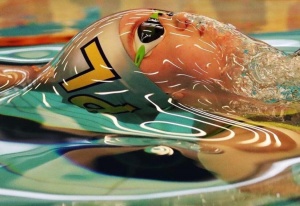
Image courtesy of renjith krishnan at FreeDigitalPhotos.net
Ever look at a beaded drop of water and go, that’s really weird? You can touch it, and it will rock back and forth and not move. And falling into water HURTS. Yet swimming is fun. Why is the matter-state between gas and solid so strange?
I mean – how is this even possible?

Bow Wave because of Water Properties – “Perfect shot” by Brian Taffy
Seems that the EDGE of water has different properties than the large mass of it, nano-size rules kick in – how molecules and atoms are structured. Studying this difference of properties become really important for anything that requires water to be moved at the small level.
Things like medicine.
We used to think water acted like water all the way up and down the scale. It doesn’t. Not even close. For example, water is a pretty good solvent. We use water wash things up because it interacts with things easily, lifting materials. It has a “dielectric constant” of 80. Dielectric constant being the polarizability of the atoms – meaning can it stick to things and stuff like that. Think how drenched you get in the rain.
At the three atom deep level, the dielectric constant is 2 – it goes from clinging to everything to teflon level – sticking only to itself. (Lowe 2018)
Water tension. Where you can touch a water bead and it doesn’t get absorbed into the skin or cling to your finger.
Applied to medicine at the protein cell level – like the construction blocks of our meat suits – you are working at the three atom level, not immersing in a bathtub. Without the understanding of how water works on the extremely small scale, figuring out how to care for our “bags of mostly water” takes on a level of difficulty leading to a lot of guess work. How do you get medicine from outside a cell into a cell? Should it be a water-soluble medicine or will a different delivery system work better?
Properties at the molecular level impacts other things as well. Water with gas in an average glass creates bubbles that float up and burst. Soda rocks!
Get a narrow enough glass, like a tube, and the bubbles stop moving. Time to call a plumber. That teflon-type “film” on the top of the water surrounds the bubble of gas, making it hard to move. Virtually stationary. (Ecole 2019)
We know how that plays out in the house. It’s called sewer backing up.
How will it play out in a spaceship with no gravity creating an up and down? How much worse will the tubing issues become for moving water around if an air bubble forms and doesn’t move? Scientists need to investigate how small the tubing can go to avoid the immobile gas bubble level.
And you thought quantum physics could be left to the physicists.
Chemistry, biology, medical science, space travel. Geeking science, dude!
Bibliography
Ecole Polytechnique Federale de Lausanne. “Student solves a 100-year-old physics enigma.” phys.org. 2019 December 2. https://phys.org/news/2019-12-student-year-old-physics-enigma.html – Last viewed 12/12/2019.
Lowe, Derek. “Water Isn’t Water Down There.” Science Translation Medicine. 2018 June 26. https://www.science.org/content/blog-post/water-isn-t-water-down-there – Last viewed 12/12/2019.
Taffy, Brian. “Perfect shot.” imgur. 2019 June 29. https://imgur.com/gallery/TJqhB2v – Last viewed 12/12/2019.
USGS. “Surface Tension and Water.” USGS – science for a changing world. (not dated). https://www.usgs.gov/special-topics/water-science-school/science/surface-tension-and-water?qt-science_center_objects=0#qt-science_center_objects – Last viewed 12/12/2019.